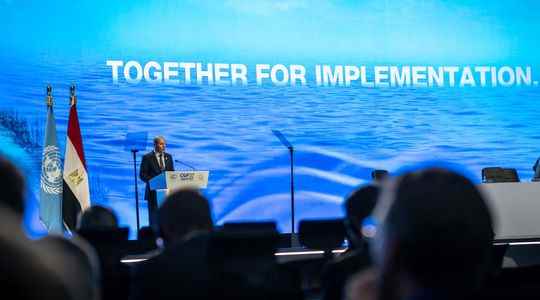It’s not a futuristic tool that would protect the Earth, but a financial mechanism. The German presidency of the G7 and some sixty vulnerable countries launched, Monday, November 14, at COP27 a “global shield against climate risks”. A new international structure, which will serve to help populations protect themselves from the impacts of global warming, and to cope with the consequences of extreme climatic events, such as droughts or floods.
- What is this shield?
Similar to an emergency fund, it should take the form of an automatic financing system, which could be triggered before or just after a climate catastrophe, according to the joint statement from Germany and the V20, which includes 58 countries. This would include, for example, insurance schemes against damage to crops, buildings or against business interruption. But also “social protection systems”, or “immediate financial support for a government to rebuild a bridge or a school”, German Development Minister Svenja Schulze told a press conference in Sharm el-Sheikh. .
The idea had been endorsed by the G7 countries at their June summit. It is a form of response to the question of the financing of “losses and damage”, which is one of the crucial points of this Egyptian COP27.
- How will it be funded?
The principle is that the highly developed countries of the North, more responsible for global warming, the consequences of which weigh mainly on the countries of the South, finance this shield. This new system has so far collected 170 million euros from Germany, as well as 60 million from France over three years, 10 million euros from Ireland, nearly 5 million euros from Denmark and 7 million dollars from Canada. President Joe Biden also announced that the United States would participate in its financing.
It will benefit a first group of countries including Bangladesh, Costa Rica, Fiji, Ghana, Pakistan, the Philippines and Senegal. But “the global shield is long overdue,” Ken Ofori-Atta, Ghana’s finance minister and V20 chairman, said in a video message, stressing that vulnerable countries are already paying for loss and damage. The V20 estimates that the damage caused by climate impacts to the economies of its members has already reached $525 billion since 2000.
- Does this announcement address the “loss and damage” issue?
The initiative is greeted with caution by NGOs and V20 countries. The latter refuse that the shield be presented as the solution to the question of “loss and damage”, while a more global fund is on the agenda of COP27.
This shield “is not a tactic to avoid any formal negotiation on loss and damage or financial arrangements at this COP”, assured the German Minister of Development. She promised that it would not be “the only solution” to this problem, and that it would in particular also have to look at slow-evolving events such as the rise of the oceans, and at “non-economic” losses.
Another tool supposed to help finance the fight against global warming in the countries of the South, the commitment of developed countries to mobilize 100 billion dollars per year (about 86 billion euros) from 2020 is still not tenuous.
